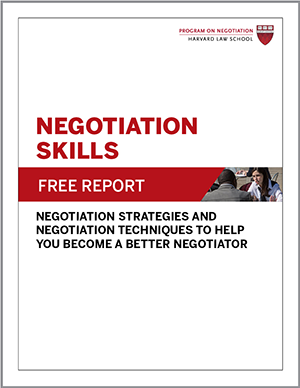
Back on August 3, 1981, 12,000 air-traffic controllers went on strike after negotiation with the federal government about wages, hours, and benefits broke down. Then-president Ronald Reagan took an uncompromising stand, using aggressive negotiation tactics to threaten the workers that if they didn’t report to work within 48 hours, they would lose their jobs.
The Role of Threats in Negotiation
On August 5, 1981 true to his word, Reagan carried out his threat and fired the 11,359 air-traffic controllers who had not returned to work. Many observers view Reagan’s controversial threat and follow-through as a pivotal moment in his presidency and the foundation for future political victories.
This story highlights the important role of threats in negotiations. Broadly speaking, a threat is a proposition that issues demands and warns of the costs of noncompliance. Even if neither party resorts to them, potential threats shadow most negotiations.
A wise threat satisfies your own interests and targets the other side’s interests. Consider whether the threat will truly help you achieve your broader goals. Issuing a threat might provide gratification, but it can also lock you into a course of action and could be costly.
Three Factors to Consider Before Making a Threat during a Negotiation
To assess whether your negotiation tactics will satisfy or violate your interests, answer these three questions:
1. Is your threat based on emotion? Effective negotiators must be immune to momentary pressures and volatile emotions. And a threat should never be made under the influence of anger: multiple studies have linked anger to reduced information processing, risky behaviors, and clouded judgment. A reliable rule of thumb is never to make a threat that you did not plan in advance.
2. Will your threat incite a counter-threat that dwarfs your own? Driven by reaction and revenge, threats often provoke counter-threats. Before making a threat, assess the potential impact of a retaliatory response, lest you initiate a battle that you aren’t prepared to fight.
3. Will aggressive negotiation tactics cost you more than it will cost the other side? Threats are not about punishing the opposition; they are about fulfilling your own interests. When you forget this important point, your desire to teach the other side a lesson may cause you to escalate a threat without regard to the toll it could take on you.
If you’ve determined that a threat would indeed serve your interests, make sure the threat will function as a motivator, not a punishment. Frame it in terms of how compliance will further your counterpart’s interests rather than how noncompliance will thwart them.
Imagine a dispute between a handheld computer company, Jansen, and a community hospital, Riverside. Jansen wanted to become a leading player in the lucrative health-care market. At the same time, Riverside needed handheld computers to increase efficiency and improve its precarious financial situation. Jansen and Riverside agreed on an information management system but, once it was installed, they argued about whether customized software was included in the deal. Without the specialized software, Riverside might be forced into bankruptcy and Jansen probably would not be paid.
Riverside could have threatened to secure the software in the language of punishment: “If we can’t reach an agreement, you’ll see little of your money.” Instead, it framed the threat in terms of Jansen’s broader interests: “If we are forced into bankruptcy, you’re unlikely to make progress in this attractive market. However, if we can reach an agreement, you will be seen as our savior and could become a market leader.” By centering the threat on the benefits of compliance, Riverside increased the probability of reaching an integrative agreement.
What are your favorite negotiation tactics? Share them with us in the comments below.
Related Article: How to Deal with Threats: 4 Negotiation Tips for Managing Conflict at the Bargaining Table
Adapted from “Putting on the Pressure: How to Make Wise Threats in Negotiation,” by Adam D. Galinsky (Professor, Northwestern University) and Katie A. Liljenquist (Assistant Professor, Brigham Young University), first published in the Negotiation newsletter.





